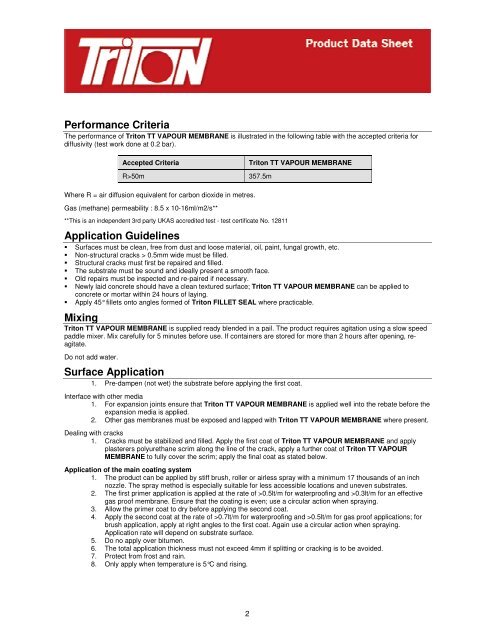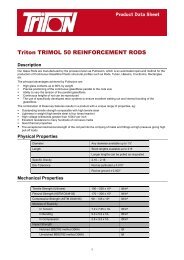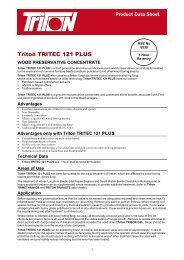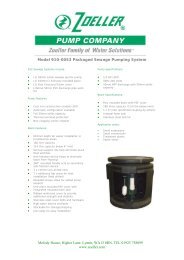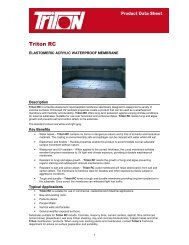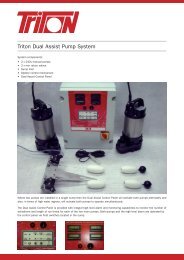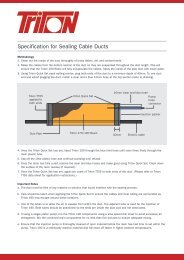Triton TT Vapour Membrane Data Sheet Download - Triton Chemicals
Triton TT Vapour Membrane Data Sheet Download - Triton Chemicals
Triton TT Vapour Membrane Data Sheet Download - Triton Chemicals
You also want an ePaper? Increase the reach of your titles
YUMPU automatically turns print PDFs into web optimized ePapers that Google loves.
Performance Criteria<br />
The performance of <strong>Triton</strong> <strong>TT</strong> VAPOUR MEMBRANE is illustrated in the following table with the accepted criteria for<br />
diffusivity (test work done at 0.2 bar).<br />
Accepted Criteria<br />
<strong>Triton</strong> <strong>TT</strong> VAPOUR MEMBRANE<br />
R>50m 357.5m<br />
Where R = air diffusion equivalent for carbon dioxide in metres.<br />
Gas (methane) permeability : 8.5 x 10-16ml/m2/s**<br />
**This is an independent 3rd party UKAS accredited test - test certificate No. 12811<br />
Application Guidelines<br />
<br />
<br />
<br />
<br />
<br />
<br />
<br />
Surfaces must be clean, free from dust and loose material, oil, paint, fungal growth, etc.<br />
Non-structural cracks > 0.5mm wide must be filled.<br />
Structural cracks must first be repaired and filled.<br />
The substrate must be sound and ideally present a smooth face.<br />
Old repairs must be inspected and re-paired if necessary.<br />
Newly laid concrete should have a clean textured surface; <strong>Triton</strong> <strong>TT</strong> VAPOUR MEMBRANE can be applied to<br />
concrete or mortar within 24 hours of laying.<br />
Apply 45° fillets onto angles formed of <strong>Triton</strong> FILLET SEAL where practicable.<br />
Mixing<br />
<strong>Triton</strong> <strong>TT</strong> VAPOUR MEMBRANE is supplied ready blended in a pail. The product requires agitation using a slow speed<br />
paddle mixer. Mix carefully for 5 minutes before use. If containers are stored for more than 2 hours after opening, reagitate.<br />
Do not add water.<br />
Surface Application<br />
1. Pre-dampen (not wet) the substrate before applying the first coat.<br />
Interface with other media<br />
1. For expansion joints ensure that <strong>Triton</strong> <strong>TT</strong> VAPOUR MEMBRANE is applied well into the rebate before the<br />
expansion media is applied.<br />
2. Other gas membranes must be exposed and lapped with <strong>Triton</strong> <strong>TT</strong> VAPOUR MEMBRANE where present.<br />
Dealing with cracks<br />
1. Cracks must be stabilized and filled. Apply the first coat of <strong>Triton</strong> <strong>TT</strong> VAPOUR MEMBRANE and apply<br />
plasterers polyurethane scrim along the line of the crack, apply a further coat of <strong>Triton</strong> <strong>TT</strong> VAPOUR<br />
MEMBRANE to fully cover the scrim; apply the final coat as stated below.<br />
Application of the main coating system<br />
1. The product can be applied by stiff brush, roller or airless spray with a minimum 17 thousands of an inch<br />
nozzle. The spray method is especially suitable for less accessible locations and uneven substrates.<br />
2. The first primer application is applied at the rate of >0.5lt/m for waterproofing and >0.3lt/m for an effective<br />
gas proof membrane. Ensure that the coating is even; use a circular action when spraying.<br />
3. Allow the primer coat to dry before applying the second coat.<br />
4. Apply the second coat at the rate of >0.7lt/m for waterproofing and >0.5lt/m for gas proof applications; for<br />
brush application, apply at right angles to the first coat. Again use a circular action when spraying.<br />
Application rate will depend on substrate surface.<br />
5. Do no apply over bitumen.<br />
6. The total application thickness must not exceed 4mm if splitting or cracking is to be avoided.<br />
7. Protect from frost and rain.<br />
8. Only apply when temperature is 5°C and rising.<br />
2


